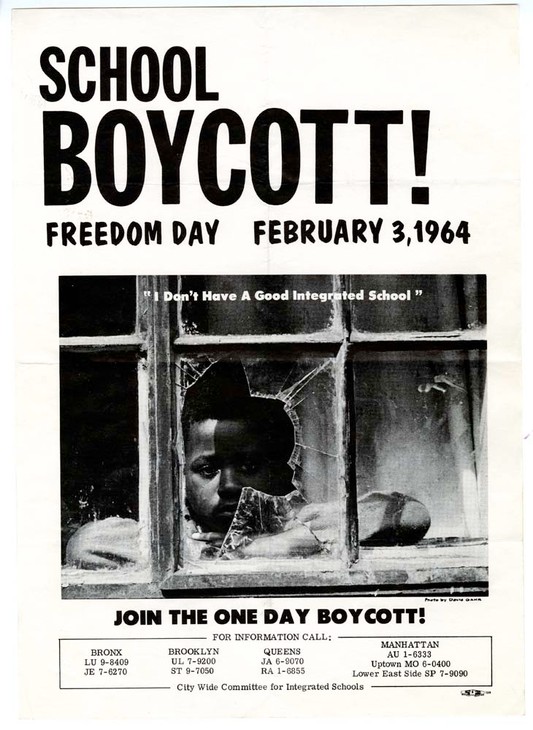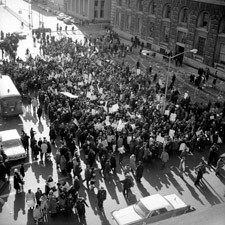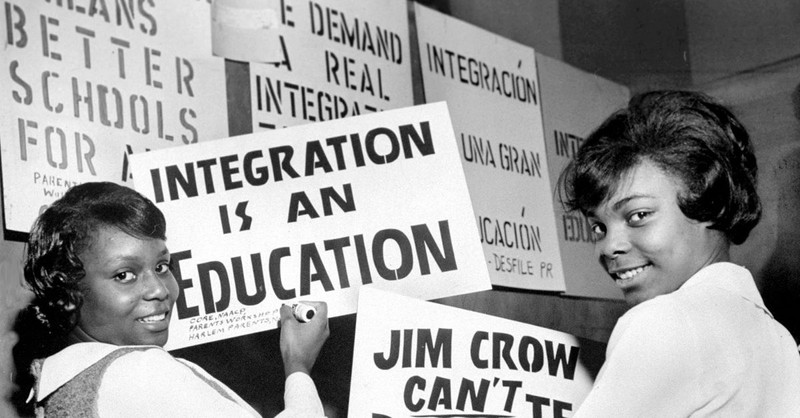New York City School Boycott 1964
Introduction
Text-to-speech Audio
Images
After negotiations failed, New York City's civil rights organizations planned a one day march and boycott of the city's school sytems, in protest of the ongoing segregation of schools.

As part of the boycott, several students skipped school on February 3 and the protesters spent the day marching to several of the city's schools and to the Board of Education in Brooklyn.

The turn out for the boycott exceeded the expectations of many. Despite this the boycott was not successful in integrating the public school system.

Backstory and Context
Text-to-speech Audio
Segregation in schools had been
outlawed in New York City in 1920 and the Brown v. Board of Education decision
made school segregation illegal on a national level. Despite this, New York
City schools were still segregated in 1964 and provided unequal learning
environments. Several states delayed the desegregation of their schools and
many were able to keep segregated schools due to surrounding segregated
communities. This was the case in New York City; segregation was not
practiced by law, but it was still a reality in communities that had been
traditionally Black and white. The kids that lived in these neighborhoods
would then attend the schools closest to where they lived, leading to
segregated schools across the city. The city had promised the schools an
integration plan for several years and the Board of Education released a plan
to draw out new districts just a few days before the boycott, but activists
said it was not enough.
In the early 1960s the boycott was proposed
by Presbyterian minister Milton Galamison who had previously served as the
president of Brooklyn's NAACP branch. He created a civil rights
organization called the Parents' Workshop for Equality in New York City Schools
that consisted of parents, teachers, and the city's civil rights advocates. The
group attempted to convince the Board of Education to create a plan for the integration
of the city’s African American and Puerto Rican schools. The organization
was unable to do so and by 1964 they requested that Bayard Rustin plan the
boycott; Rustin helped plan the 1963 March on Washington and the Freedom Ride of
1947. Along with the city's civil rights organizations and pastors, Rustin
planned the boycott for February 3 and provided freedom schools for students to
attend if they planned to partake in the boycott. These civil rights
organizations included the City-Wide Committee for Integrated Schools, CORE,
NAACP, Parents' Workshop for Equality, and the Harlem Parents Committee.
On February 3 the boycott began when
464,000 students refused to attend school and several protesters marched to the
city's schools and to the Board of Education. At the Freedom Schools,
students were taught about slavery, what it meant to be free, and sang songs
like the popular "We Shall Overcome." While there was a fear of
violence, the boycott remained peaceful, and received more support than people
thought it would. However, it did not succeed in integrating the city’s
African American and Puerto Rican schools and communities. Even today
several schools in the city are still segregated due to the Board of
Education's failure to fully address the issue.
Sources
"On this Day in History, February 3: New York City School Boycott." Brooklyn Daily Eagle. Accessed on October 11, 2017. http://www.brooklyneagle.com/articles/day-history-february-3-new-york-city-school-boycott
"New York School Boycott." Civil Rights Digital Library. Accessed on October 11, 2017. http://crdl.usg.edu/events/ny_school_boycott/
